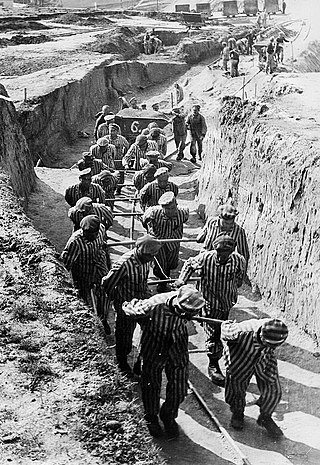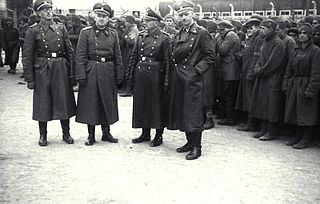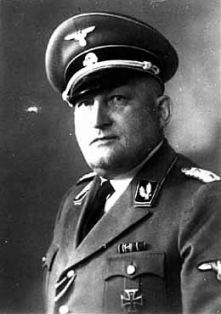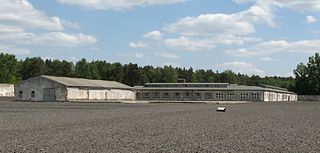Karl-Otto Koch was a mid-ranking commander in the Schutzstaffel (SS) of Nazi Germany who was the first commandant of the Nazi concentration camps at Buchenwald and Sachsenhausen. From September 1941 until August 1942, he served as the first commandant of the Majdanek concentration camp in occupied Poland, stealing vast amounts of valuables and money from murdered Jews. His wife, Ilse Koch, also took part in the crimes at Buchenwald.

Theodor Eicke was a senior SS functionary and Waffen SS divisional commander during the Nazi era. He was one of the key figures in the development of Nazi concentration camps. Eicke served as the second commandant of the Dachau concentration camp from June 1933 to July 1934, and together with his adjutant Michael Lippert, was one of the executioners of SA Chief Ernst Röhm during the Night of the Long Knives purge of 1934. He continued to expand and develop the concentration camp system as the first Concentration Camps Inspector.

Aufseherin was the position title for a female guard in Nazi concentration camps. Of the 50,000 guards who served in the concentration camps, approximately 5,000 were women. In 1942, the first female guards arrived at Auschwitz and Majdanek from Ravensbrück. The year after, the Nazis began conscripting women because of a shortage of male guards. In the context of these camps, the German position title of Aufseherin translates to (female) "overseer" or "attendant". Later female guards were dispersed to Bolzano (1944–1945), Kaiserwald-Riga (1943–44), Mauthausen, Stutthof (1942–1945), Vaivara (1943–1944), Vught (1943–1944), and at Nazi concentration camps, subcamps, work camps, detention camps and other posts.

From 1933 to 1945, Nazi Germany operated more than a thousand concentration camps, including subcamps on its own territory and in parts of German-occupied Europe.
Johanna Langefeld was a Nazi German guard and supervisor at three Nazi concentration camps: Lichtenburg, Ravensbrück, and Auschwitz. She was arrested and imprisoned for her role in the Holocaust, but she escaped prison and was never tried.

SS-Totenkopfverbände was the Schutzstaffel (SS) organization responsible for administering the Nazi concentration camps and extermination camps for Nazi Germany, among similar duties. While the Totenkopf was the universal cap badge of the SS, the SS-TV also wore this insignia on the right collar tab to distinguish itself from other SS formations.

Richard Glücks was a high-ranking German Nazi official in the SS. From November 1939 until the end of World War II, he was Concentration Camps Inspector (CCI), which became Amt D: Konzentrationslagerwesen under the WVHA in Nazi Germany. As a direct subordinate of Heinrich Himmler, he was responsible for the forced labour of the camp inmates and was also the supervisor for the medical practices in the camps, ranging from human experimentation to the implementation of the "Final Solution", in particular the mass murder of inmates with Zyklon B gas. After Germany capitulated, Glücks committed suicide by swallowing a potassium cyanide capsule.
Three concentration camps operated in succession in Moringen, Lower Saxony, from April 1933 to April 1945. KZ Moringen, established in the centre of the town on site of former 19th century workhouses, originally housed mostly male political inmates. In November 1933 - March 1938 Moringen housed a women's concentration camp; in June 1940 - April 1945 a juvenile prison. A total of 4,300 people were prisoners of Moringen; an estimated ten percent of them died in the camp.

Anton Kaindl was an SS-Standartenführer and commandant of the Sachsenhausen concentration camp from 1943-1945.

The Concentration Camps Inspectorate (CCI) or in German, IKL was the central SS administrative and managerial authority for the concentration camps of the Third Reich. Created by Theodor Eicke, it was originally known as the "General Inspection of the Enhanced SS-Totenkopfstandarten", after Eicke's position in the SS. It was later integrated into the SS Main Economic and Administrative Office as "Amt D".
Arthur Rödl was a German Standartenführer (Colonel) in the Waffen-SS and a Nazi concentration camp commandant.

Ravensbrück was a German concentration camp exclusively for women from 1939 to 1945, located in northern Germany, 90 km (56 mi) north of Berlin at a site near the village of Ravensbrück. The camp memorial's estimated figure of 132,000 women who were in the camp during the war includes about 48,500 from Poland, 28,000 from the Soviet Union, almost 24,000 from Germany and Austria, nearly 8,000 from France, and thousands from other countries including a few from the United Kingdom and the United States. More than 20,000 of the total were Jewish. Eighty-five percent were from other races and cultures. More than 80% were political prisoners. Many prisoners were employed as slave labor by Siemens & Halske. From 1942 to 1945, the Nazis undertook medical experiments on Ravensbrück prisoners to test the effectiveness of sulfonamides.
Johanna Braach was Chief Secretary in the "Reich Central Office for combating the juvenile delinquency" and Deputy Head of the girls' concentration camp at Uckermark.

Alexander Bernhard Hans Piorkowski was a German SS functionary during the Nazi era and commandant of Dachau concentration camp. Following the war, he was convicted and executed.
Albert Sauer was a Nazi German commandant of Mauthausen-Gusen concentration camp. He died of wounds in 1945, and was never tried for his role in The Holocaust.
Günther Tamaschke was a Nazi German SS-Standartenführer and commandant of the Lichtenburg and Ravensbrück concentration camps. He was never tried for his role in the Holocaust.
In Nazi Germany, the Standarte was a paramilitary unit of Nazi Party (NSDAP), Sturmabteilung (SA), NSKK, NSFK, and Schutzstaffel (SS). Translated literally as "Regimental standard", the name refers to the flag paramilitary formations carried in formations and parades.
Karl Taus was an Austrian Nazi and SS-Brigadeführer. During the Second World War, he served as the SS and Police Leader in Görz.
Like other areas under Nazi Germany, Jews were persecuted in the northernmost German state Schleswig-Holstein. Before the Nazis came to power in 1933, an estimated 1,900 Jews lived in Schleswig-Holstein, mostly in Lübeck and Kiel. By the time of Nazi Germany's defeat in 1945, many of Schleswig-Holstein's Jews had been murdered in the Holocaust.










